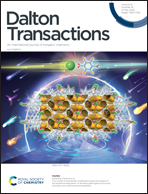Enhancing the remarkable adsorption of Pb2+ in a series of sulfonic-functionalized Zr-based MOFs: a combined theoretical and experimental study for elucidating the adsorption mechanism†
Abstract
A series of Zr-based metal–organic frameworks was prepared via the solvothermal route using sulfonic-rich linkers for the efficient capture of Pb2+ ions from aqueous medium. The factors affecting adsorption such as the solution pH, adsorbent dosage, contact time, adsorption isotherms, and mechanism were studied. Consequently, the maximum adsorption capacity of Pb2+ on the acidified VNU-23 was determined to be 617.3 mg g−1, which is much higher than that of previously reported adsorbents and MOF materials. Furthermore, the adsorption isotherms and kinetics of the Pb2+ ion are in good accordance with the Langmuir and pseudo-second-order kinetic model, suggesting that the uptake of Pb2+ is a chemisorption process. The reusability experiments demonstrated the facile recovery of the H+⊂VNU-23 material through immersion in an HNO3 solution (pH = 3), where its Pb2+ adsorption efficiency still remained at about 90% of the initial uptake over seven cycles. Remarkably, the adsorption mechanism was elucidated through a combined theoretical and experimental investigation. Accordingly, the Fourier transform infrared spectroscopy (FT-IR), Raman spectroscopy, scanning electron microscopy connected to energy-dispersive X-ray mapping (SEM-EDX-mapping), and X-ray photoelectron spectroscopy (XPS) analysis of the Pb⊂VNU-23 sample and comparison with H+⊂VNU-23 confirmed that the electrostatic interaction occurs via the interaction between the SO3− moieties in the framework and the Pb2+ ion, leading to the formation of a Pb–O bond. In addition, the density functional theory (DFT) calculations showed the effective affinity of the MOF adsorbent toward the Pb2+ ion via the strong driving force mentioned in the experimental studies. Thus, these findings illustrate that H+⊂VNU-23 can be employed as a potential adsorbent to eliminate Pb2+ ions from wastewater.



 Please wait while we load your content...
Please wait while we load your content...